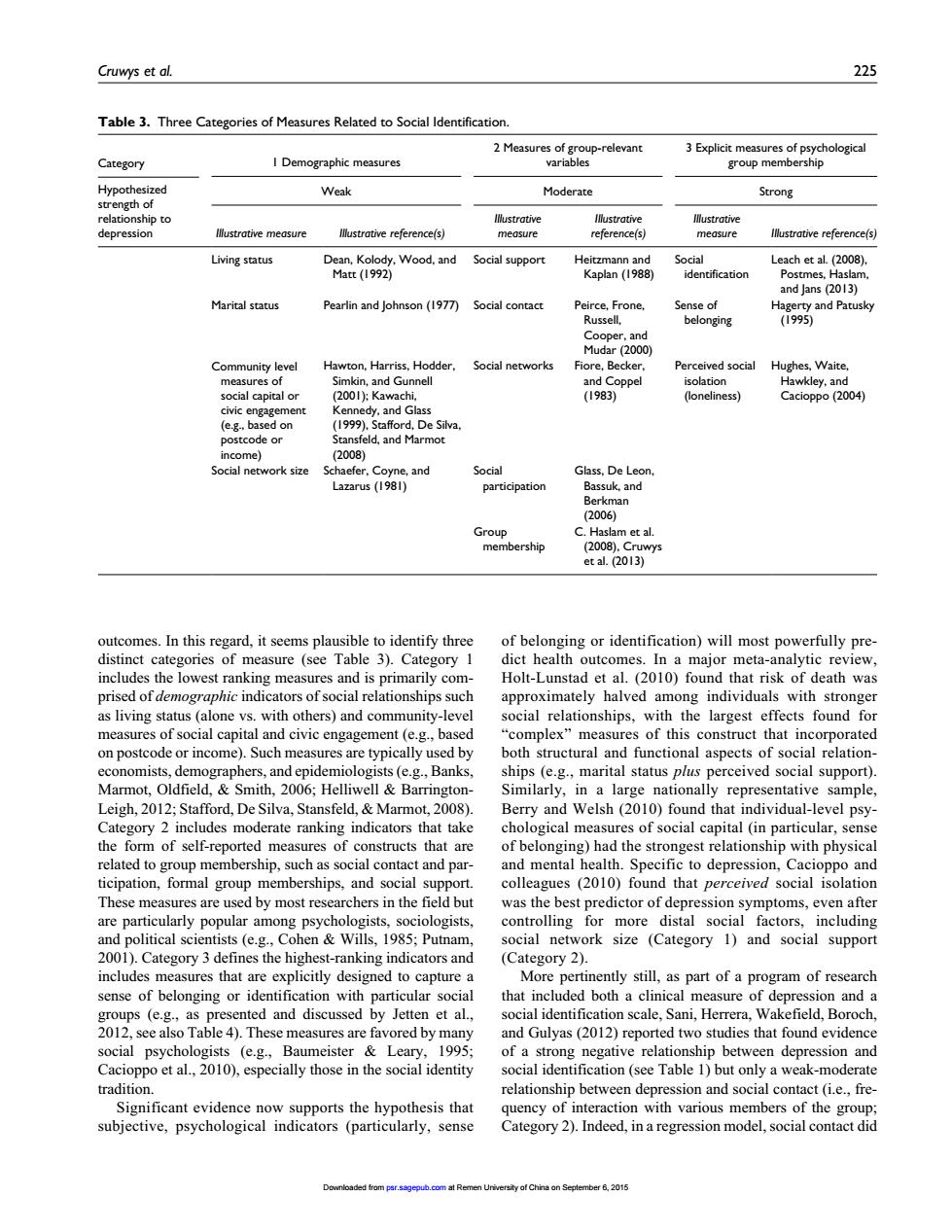正在加载图片...

Cruwys et a 225 Table3.Three of Measures Related relevant 3 Explic Category measure Weak Moderate Strong lllustrative measure reference(s) llustrative referenceis Living status Social support Kapln (1) Leach et al (008). and lans 2013) Marital status Pearlin and lohnson (1977)Social contact Peirce.Frone. 1995 Fiore.Bec (1983 Cacioppo (2004 nd C D ode or tal network size Sc 2006 et al. ct al (2013) outcomes.In this regard.it seems plausible to identify three of belonging or identification)will most powerfully pre distinct categories of measure (see Table 3).Category Holt-I et a th wa as living status (alone ys with others)and cor munity-love app with the la t effects found f measures of social capital and civic engagement (e.gbased g.,ma Leigh,2012:Stafford,De Silva.Stansfeld,&Marmot.2008) Berry and Welsh (2010)found that individual-level psy Category 2 includes moderate ranking indicators that take chological measures of social capital (in particular,se rm of self-rep of belonging)h e str ngest lation ship with physica wes (2010)found tha epres These measures are used by most researchers in the field but controlling for more distal social factors,including 3 e-8 (ca ne ork size (Category 1)and social support More pe inently still as nart of a n sense of belonging or identification with articular social that included both a clinical measure of depression and a pres I and discussed by Jette n et al. social identif cation scale,Sani,Herrera,Wakefield,Boroch easures ar lyas (2012)rep es th al d by moos 00ctal2010. social identification (see Table D but only a weak-moderat relationship between depression and social contact(i.e.,fre quency of cators (particularly.sens 304 Cruwys et al. 225 outcomes. In this regard, it seems plausible to identify three distinct categories of measure (see Table 3). Category 1 includes the lowest ranking measures and is primarily comprised of demographic indicators of social relationships such as living status (alone vs. with others) and community-level measures of social capital and civic engagement (e.g., based on postcode or income). Such measures are typically used by economists, demographers, and epidemiologists (e.g., Banks, Marmot, Oldfield, & Smith, 2006; Helliwell & BarringtonLeigh, 2012; Stafford, De Silva, Stansfeld, & Marmot, 2008). Category 2 includes moderate ranking indicators that take the form of self-reported measures of constructs that are related to group membership, such as social contact and participation, formal group memberships, and social support. These measures are used by most researchers in the field but are particularly popular among psychologists, sociologists, and political scientists (e.g., Cohen & Wills, 1985; Putnam, 2001). Category 3 defines the highest-ranking indicators and includes measures that are explicitly designed to capture a sense of belonging or identification with particular social groups (e.g., as presented and discussed by Jetten et al., 2012, see also Table 4). These measures are favored by many social psychologists (e.g., Baumeister & Leary, 1995; Cacioppo et al., 2010), especially those in the social identity tradition. Significant evidence now supports the hypothesis that subjective, psychological indicators (particularly, sense of belonging or identification) will most powerfully predict health outcomes. In a major meta-analytic review, Holt-Lunstad et al. (2010) found that risk of death was approximately halved among individuals with stronger social relationships, with the largest effects found for “complex” measures of this construct that incorporated both structural and functional aspects of social relationships (e.g., marital status plus perceived social support). Similarly, in a large nationally representative sample, Berry and Welsh (2010) found that individual-level psychological measures of social capital (in particular, sense of belonging) had the strongest relationship with physical and mental health. Specific to depression, Cacioppo and colleagues (2010) found that perceived social isolation was the best predictor of depression symptoms, even after controlling for more distal social factors, including social network size (Category 1) and social support (Category 2). More pertinently still, as part of a program of research that included both a clinical measure of depression and a social identification scale, Sani, Herrera, Wakefield, Boroch, and Gulyas (2012) reported two studies that found evidence of a strong negative relationship between depression and social identification (see Table 1) but only a weak-moderate relationship between depression and social contact (i.e., frequency of interaction with various members of the group; Category 2). Indeed, in a regression model, social contact did Table 3. Three Categories of Measures Related to Social Identification. 1 Demographic measures 2 Measures of group-relevant variables 3 Explicit measures of psychological Category group membership Hypothesized Weak Moderate Strong strength of relationship to depression Illustrative measure Illustrative reference(s) Illustrative measure Illustrative reference(s) Illustrative measure Illustrative reference(s) Living status Dean, Kolody, Wood, and Matt (1992) Social support Heitzmann and Kaplan (1988) Social identification Leach et al. (2008), Postmes, Haslam, and Jans (2013) Marital status Pearlin and Johnson (1977) Social contact Peirce, Frone, Russell, Cooper, and Mudar (2000) Sense of belonging Hagerty and Patusky (1995) Community level measures of social capital or civic engagement (e.g., based on postcode or income) Hawton, Harriss, Hodder, Simkin, and Gunnell (2001); Kawachi, Kennedy, and Glass (1999), Stafford, De Silva, Stansfeld, and Marmot (2008) Social networks Fiore, Becker, and Coppel (1983) Perceived social isolation (loneliness) Hughes, Waite, Hawkley, and Cacioppo (2004) Social network size Schaefer, Coyne, and Lazarus (1981) Social participation Glass, De Leon, Bassuk, and Berkman (2006) Group membership C. Haslam et al. (2008), Cruwys et al. (2013) Downloaded from psr.sagepub.com at Remen University of China on September 6, 2015